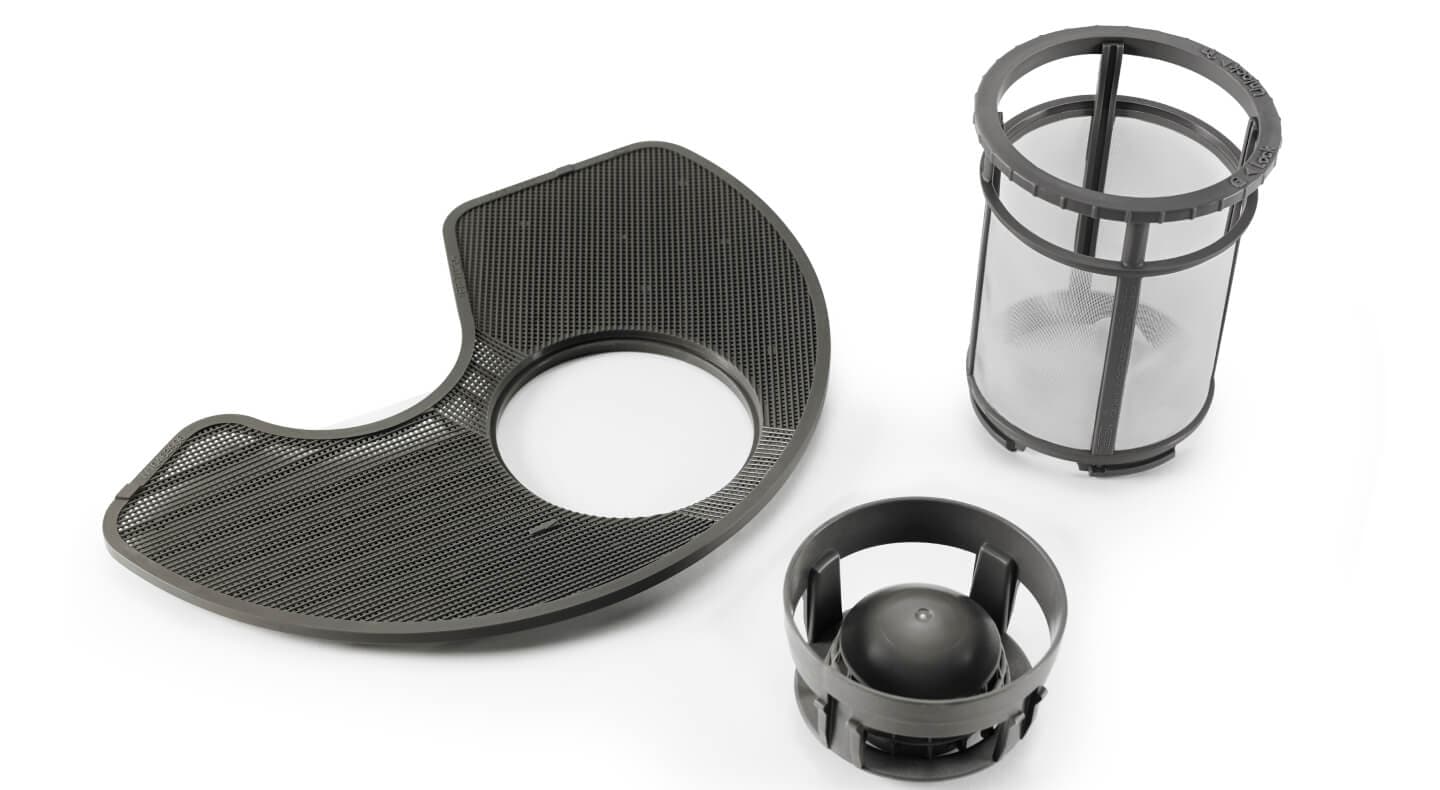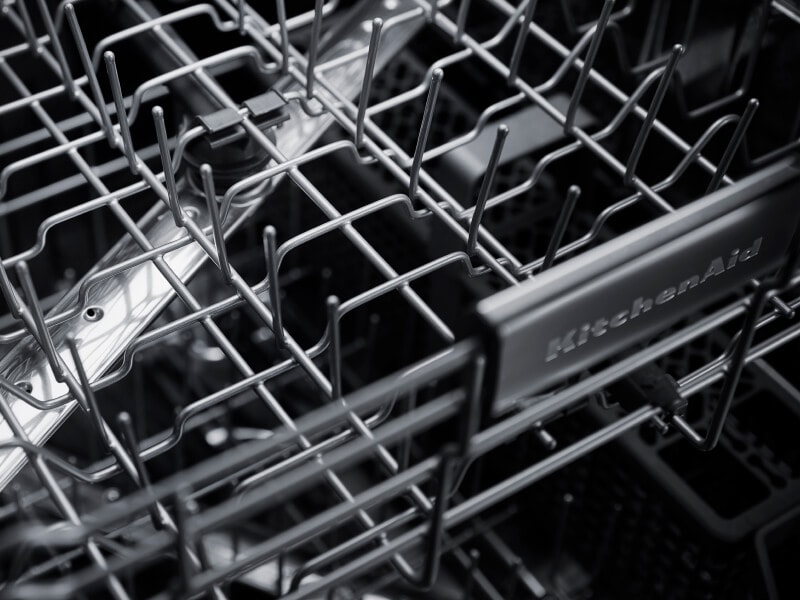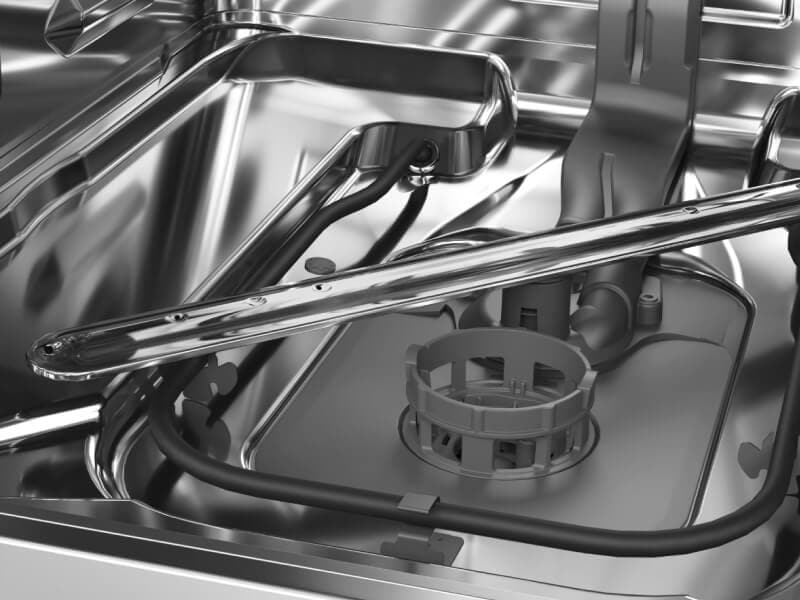
How to clean a dishwasher filter quickly & easily
Keeping your dishwasher’s filter free of buildup and debris helps ensure your appliance can keep up with your culinary pursuits. The dishwasher filter is responsible for clearing dishwater, preventing clogs and keeping food particles off of your dishes, once they’ve been washed free of soil. Washing your filter helps to keep dishes coming out fresh and ready for your next meal. Luckily, cleaning a dishwasher filter is a simple task that can be completed in a few minutes with the help of this step-by-step guide.
Note that select KitchenAid® dishwashers feature maintenance-free filters that don’t require any regular cleaning or maintenance.


Dishwasher filter cleaning instructions
Exact cleaning instructions will vary by make and model, however, for many dishwashers that require you to clean the filter, you can simply remove the bottom rack to access the filter. Once you’ve done this, you can detach it, rinse thoroughly under warm water, and then securely reinstall it in your dishwasher.
Use these step-by-step instructions in conjunction with your dishwasher’s product manual to help prepare your dishwasher filter for the next use.
What you’ll need
Warm water
Toothbrush or soft sponge
Sink or large bowl

Step 1: Pull the bottom rack out
To access your dishwasher filter, you’ll usually need to completely remove the bottom rack from the appliance. Once removed, set it to the side.

Step 2: Locate and remove your dishwasher filter
Typically, filters are located at the bottom of a dishwasher, beneath the bottom rack. Be sure to handle the dishwasher filter carefully, as a damaged filter can lead to poor performance. Depending on your dishwasher model, the filter may be composed of two parts: an upper filter assembly and a lower filter.
To remove the filter, gently turn the upper assembly a quarter turn counterclockwise and lift it out. Lightly grasp the lower filter, lifting it slightly and pull forward to complete the removal.

Step 3: Rinse the filter with warm water
Most soils and residue can be removed by simply rinsing the filter with warm water. For more challenging food particles, soak the filter in warm water for a few minutes. You can use an old toothbrush or a sponge to gently scrub away calcium deposits or stuck-on pieces of food. It is never recommended to use a wire brush or a wire sponge, as they may damage the filter.
Cleaning tip: How to deep clean a dishwasher filter
If you’ve gone a while without cleaning your dishwasher filter and it needs a deeper cleaning, the solution is likely already in your pantry. After rinsing the filter and gently removing stubborn residue, you can soak the filter in a mixture of white vinegar and warm water for at least 30 minutes.

Step 4: Reinstall your filter
Once you’ve finished cleaning your filter, return the lower filter to the dishwasher tub. Instructions for reinstallation may vary based on the make and model of your dishwasher, so always consult your product manual before you begin.
If you have a KitchenAid® dishwasher without a maintenance-free filter, you can locate it under the tabs to allow the upper assembly to line up properly. Insert the upper filter assembly into the circular opening of the lower filter. Turn the filter clockwise until you feel it drop into position. If the filter continues to turn freely, it isn’t fully installed. Continue to turn the filter clockwise until it drops and locks into place. To avoid damaging your dishwasher, verify that both the lower and upper filters are in the locked position and no large gaps are present around the filter perimeters before running. If you need any additional help with your KitchenAid® dishwasher, check your product manual or use the online service and support help desk.



Need help finding your next dishwasher?
Do all dishwashers have a filter?
All dishwashers have a filter, however not all of them require regular maintenance. The location, type and instructions about how to keep the dishwasher clean may vary depending on the make and model of the appliance. Be sure to consult your product manual before removing and cleaning the filter.
Learn more about the importance of dishwasher filtration systems with this guide on how a dishwasher works.
Select KitchenAid® dishwashers with the Advanced Clean Water Wash System feature a maintenance-free filter system that doesn’t require any regular cleaning or maintenance. This system only requires you to occasionally empty a cup that prevents foreign objects from entering the dishwasher pump if it fills with particles or objects.
Shop KitchenAid® dishwashers with the advanced clean water wash system
KitchenAid® dishwashers with the advanced clean water wash system use microfiltration to continuously remove food particles during the wash and rinse cycles and circulate clean water to dishes in all three racks. This allows dirty cookware and delicate glassware to be washed together in the same load.

KITCHENAID® DISHWASHERS
Create more, clean up less
KitchenAid® dishwashers make kitchen cleanup easy, so you can focus less on cleaning and more on making
How often should you clean the filter in a dishwasher?
Your dishwasher filter should be cleaned anywhere from once a year to once a week, depending on how often you run the appliance. On average, you should clean your filter every three to six months.
To better determine how often you need to clean your filter, keep track of how often you use your dishwasher. The more you use it, the more often you may need to clean your filter.
Note: Depending on the make and model of your dishwasher, you usually do not need to pre-wash your dishes before they go into the appliance. However, it is recommended that you scrape large pieces of food off your plates before placing them in the dishwasher.
| Loads per week | Cleaning schedule |
|---|---|
| 1-3 loads per week (rinsed and scraped) | Once a year |
| 1-3 loads per week (scraped only) | Twice a year |
| 1-3 loads per week (no pre-rinsing or scraping) | Every other month |
| 4-7 loads per week (rinsed and scraped) | Once a year |
| 4-7 loads per week (scraped only) | Twice a year |
| 4-7 loads per week (no pre-rinsing or scraping) | Monthly |
| 8-12 loads per week (rinsed and scraped) | Twice a year |
| 8-12 loads per week (scraped only) | Every three months |
| 8-12 loads per week (no pre-rinsing or scraping) | Every two weeks |
What happens if you don’t clean your dishwasher filter?
Without proper maintenance, food particles and grime can build up in the filter. This can affect the performance of your dishwasher and could even lead to unwanted odors. In extreme cases, a dirty filter may lead to a broken dishwasher.
Keep your dishwasher filter clean so you can spend less time rinsing dishes and more time creating meals in your kitchen. Select KitchenAid® dishwashers offer maintenance-free filters that free up more time for you in the kitchen.
When should you replace your dishwasher filter?
If you notice any damage or visible signs of wear on your dishwasher filter, it may be time to replace it. To help guarantee compatibility, always opt for replacement parts from the same manufacturer as your appliances.
Explore KitchenAid® dishwashers
KitchenAid® dishwashing appliances make clean up easy, so you can spend more time exploring your culinary curiosities. With finishes like stainless steel and panel-ready and various features on select models, including extra capacity with the Third Level Rack, KitchenAid brand has the dishwasher options to suit your kitchen’s needs.

Destination: Design
Follow the path to inspiration
Join two creative storytellers as they travel to a unique destination, and watch as KitchenAid brand transforms their inspiration into stunning designs

